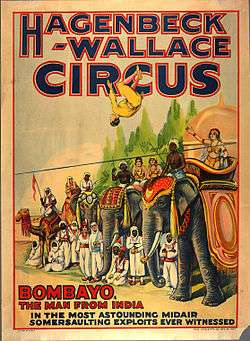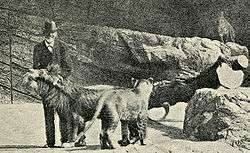Carl Hagenbeck
Carl Hagenbeck (June 10, 1844 – April 14, 1913) was a German merchant of wild animals who supplied many European zoos, as well as P. T. Barnum.[1] He created the modern zoo with animal enclosures without bars that were closer to their natural habitat.[2] The transformation of the zoo architecture initiated by him is known as the Hagenbeck revolution.[3] Hagenbeck founded Germany's most successful privately owned zoo, the Tierpark Hagenbeck, which moved to its present location in Hamburg's Stellingen district in 1907. He was also an ethnography showman and a pioneer in displaying humans next to animals in human zoos.[4]
Carl Hagenbeck | |
|---|---|
 | |
| Born | June 10, 1844 |
| Died | April 14, 1913 (aged 68) Hamburg, Germany |
| Nationality | German |
| Known for |
|
| Spouse(s) | Amanda (n. Mehrman) |
| Children | 2 |
| Parent(s) | Claus Gottfried Carl Hagenbeck |


Biography
Hagenbeck was born on June 10, 1844, to Claus Gottfried Carl Hagenbeck (1810–1887), a fishmonger who ran a side business buying, showing and selling exotic animals.[5]
When Hagenbeck was 14, his father gave him some seals and a polar bear.[5][6] He took a more proactive role in the animal trade and his collection of animals grew until he needed large buildings to keep them. Hagenbeck left his home in Hamburg to accompany hunters and explorers on trips to jungle regions and snow-clad mountains. He captured animals in nearly every continent in the world. In 1874, he decided to exhibit Samoan and Sámi people (then known as Laplanders) as "purely natural" populations, with their tents, weapons, sleds, near a group of reindeer.[7][8]
In 1875, Hagenbeck began to exhibit his animals in all the large cities of Europe as well as in the United States.
In 1876, he sent a collaborator to the Egyptian Sudan to bring back some wild beasts and Nubians. The Nubian exhibit was a success in Europe, and toured Paris, London, and Berlin.[7] In 1880, his agent Johan Adrian Jacobsen recruited a group of eight Labrador Inuit. The group toured Hamburg, Berlin, Prague, Frankfurt, Darmstadt, Krefeld and Paris. One member of the group, Abraham Ulrikab, kept a diary during his travels in Europe. All eight Inuit were killed by smallpox.
Hagenbeck's exhibit of human beings, considered as "savages in a natural state," was the probable source of inspiration for Albert Geoffroy Saint-Hilaire's similar "human zoo" exhibition in the Jardin d'acclimatation in Paris. Saint-Hilaire organized in 1877 two "ethnological exhibitions," presenting Nubians and Greenlandic Inuit to the public, thereby doubling the number of visitors of the zoo.[7]
Hagenbeck also trained animals for his circuses at the World's Columbian Exposition in Chicago, Illinois, in 1893, and the Louisiana Purchase Exposition in St. Louis in 1904. Hagenbeck's circus was one of the most popular attractions. His collection included large animals and reptiles. Many of the animals were trained to do tricks. Hagenbeck's trained animals also performed at amusement parks in New York City's Coney Island prior to 1914.
Hagenbeck planned a permanent exhibit where animals could live in surroundings like their natural homes. Despite the existence of the Zoological Garden of Hamburg, Hagenbeck opened his great zoo, the Tierpark Hagenbeck at Stellingen, near Hamburg in 1907.[6]
In 1909-1910 he supervised the building of the Giardino Zoologico in Rome. Today his ideas are followed by most large zoos.
In 1905, Hagenbeck used his outstanding skills as an animal collector to capture a thousand camels for the German Empire for use in Africa. He described his adventures and his methods of capturing and training animals in his book Beasts and Men, published in 1909.
Hagenbeck was one of the first Europeans to describe a creature that came to be known as Mokele-mbembe.[9] In Beasts and Men Hagenbeck claimed he had received reports of "a huge monster, half elephant, half dragon" inhabiting the interior of Rhodesia. Hagenbeck thought the animal was some kind of dinosaur similar to a brontosaurus and unsuccessfully searched for it. His claim made headlines in newspapers around the world and helped launch the legend of Mokele Mbembe.
Hagenbeck died on April 14, 1913, in Hamburg from a bite by a snake, probably a boomslang.[1] After Hagenbeck's death his sons Heinrich and Lorenz continued the zoo and circus business; the Hamburg zoo still retains his name.
See also
- Salt and Sauce, United Kingdom elephants originally bought and imported by Carl Hagenbeck
References
- "Carl Hagenbeck. Famous Animal Dealer and Exhibitor Dies in Hamburg". The New York Times. April 14, 1913. Retrieved 2008-07-22.
Carl Hagenbeck, the animal collector and senior partner of the ... menagerie and park at Stellingen, near Hamburg died to-day.
- "Hagenbeck Tierpark und Tropen-Aquarium". Zoo and Aquarium Visitor. Archived from the original on 2009-12-21. Retrieved 2008-07-22.
The founder and his idea Carl Hagenbeck built what no other dared dream of. In 1907, the Hamburg man opened the first barless zoo in the world. As early as the end of the nineteenth century, this son of a fishmonger had the idea of showing animals no longer caged up but in open viewing enclosures. In his zoo of the future, nothing more than unseen ditches were to separate wild animals from members of the public. Carl Hagenbeck patented this idea in 1896. Nine years later his dream was to come true in the Stellingen district of Hamburg. The revolutionary open viewing enclosures and panoramas were in fact ridiculed in professional circles but took the public's breath away. Hagenbeck's zoo is considered to have prepared the way for today's wildlife adventure parks.
- "Managing Love and Death at the Zoo: The Biopolitics of Endangered Species Preservation" Archived 2012-11-24 at the Wayback Machine, Australian Humanities Review, Issue 50, May 2011
- Ames, Eric (2008). Carl Hagenbeck's Empire of Entertainments. Seattle & London: University of Washington Press. ISBN 978-0-295-98833-7.
- 46;Nigel Rothfels, Savages and Beasts: The Birth of the Modern Zoo. (Baltimore: The Johns Hopkins University Press, 2002)
- Chisholm 1911.
- Human Zoos, by Nicolas Bancel, Pascal Blanchard and Sandrine Lemaire, in Le Monde diplomatique, August 2000 French
- Savages and Beasts - The Birth of the Modern Zoo, Nigel Rothfels, Johns Hopkins University Press
- Loxton, Daniel; Prothero, Donald R. (2013). Abominable Science! Origins of the Yeti, Nessie, and Other Famous Cryptids. New York: Columbia University Press. p. 270. ISBN 9780231153201.
- "The Code Online". International Commission of Zoological Nomenclature.
Further reading
Chisholm, Hugh, ed. (1911). . Encyclopædia Britannica (11th ed.). Cambridge University Press.
- Carl Hagenbeck, Beasts and men. Being Carl Hagenbeck's experiences for half a century among wild animals. (London & New York: Longmans, Green, and Co., 1912).
- Eric Ames, Carl Hagenbeck's Empire of Entertainments (Seattle and London: University of Washington Press, 2009)
- Edward Alexander, “Carl Hagenbeck and His Stellingen Tierpark: The Moated Zoo,” in: Edward Alexander, Museum Masters: Their Museums and Their Influence. (Nashville: American Association for State and Local History, 1983), pp. 311–340.
- Herman Reichenbach, “A Tale of Two Zoos: The Hamburg Zoological Garden and Carl Hagenbeck’s Tierpark,” in: R. J. Hoage and William A. Deiss, eds. New Worlds, New Animals. (Baltimore: Johns Hopkins University Press, 1996), pp. 51–62.
- Nigel Rothfels, Savages and Beasts: The Birth of the Modern Zoo. (Baltimore: The Johns Hopkins University Press, 2002).
- Reptiles of the world by Raymond L. Ditmar talks about him capturing most of the Gavhrials found on exhibit.
Spartaco Gippoliti 2004 Carl Hagenbeck's plan for Rome Zoo - and what became of it. Int. Zoo News 51: 24-28.
External links
| Wikimedia Commons has media related to Carl Hagenbeck. |
| Wikisource has the text of a 1905 New International Encyclopedia article about Carl Hagenbeck. |
- Karl Hagenbeck: Von Tieren und Menschen. Ausgabe von 1909. Digitalisat der University of Toronto.(in German)
- Hagenbeck, Carl (1909) Beasts and Men, being Carl Hagenbeck's experiences for half a century among wild animals (English translation) - digital facsimile from Linda Hall Library
- Newspaper clippings about Carl Hagenbeck in the 20th Century Press Archives of the ZBW